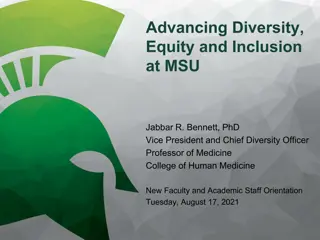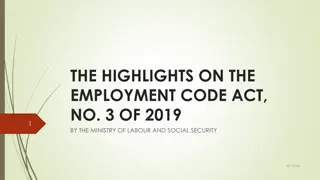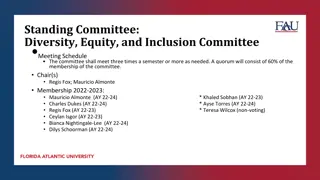Rainbow-Inclusive Workplaces Standard: Promoting Diversity in Employment
"The Rainbow-Inclusive Workplaces Standard (NZS 8200:2015) is a groundbreaking initiative in New Zealand, setting guidelines for organizations to create inclusive and safe workplaces for individuals of diverse sexual orientations and gender identities. The standard aims to address discrimination and exclusion faced by LGBTQI communities in the workforce, emphasizing the benefits of authenticity and inclusivity in enhancing workplace performance. Developed with input from various organizations, this standard helps employers foster environments where all employees can thrive."
Download Presentation

Please find below an Image/Link to download the presentation.
The content on the website is provided AS IS for your information and personal use only. It may not be sold, licensed, or shared on other websites without obtaining consent from the author.If you encounter any issues during the download, it is possible that the publisher has removed the file from their server.
You are allowed to download the files provided on this website for personal or commercial use, subject to the condition that they are used lawfully. All files are the property of their respective owners.
The content on the website is provided AS IS for your information and personal use only. It may not be sold, licensed, or shared on other websites without obtaining consent from the author.
E N D
Presentation Transcript
RAINBOW-INCLUSIVE WORKPLACES A Standard for gender and sexual diversity in employment
WORLD FIRST The first standard in the world to assist organisations achieve a truly inclusive workplace has been published in New Zealand Standards New Zealand recently published NZS 8200:2015 Rainbow-inclusive workplaces: A standard for gender and sexual diversity in employment. NZS 8200 outlines the requirements to be met for organisations to be recognized as inclusive and safe workplaces for people of diverse sexual orientation and gender identity.
International research shows that people from the lesbian, gay, bisexual, trans, takataapui, queer, and intersex (LGBTTQI) communities sill face discrimination and exclusion in the workforce; in recruitment, retention, training, and advancement opportunities. There is also research that indicates that workplaces that support and encourage staff to be authentic and bring the whole of themselves to work perform better than those where people feel they must hide a central aspect of themselves. The standard sets out five categories of criteria to be met and can be applied across organisations of all sizes. Implementing this standard will help employers create safe workplaces where staff can be themselves, be happier at work, and be more productive.
STANDARDS NZ COMMITTEE The standard was prepared under the supervision of the P 8200 Committee Standards Council established under the Standards Act 1988. The committee consisted of representatives of the following nominating organisations: Affinity Services, Auckland Chamber of Commerce, gQ network, New Zealand Council of Trade Unions (Art Daniel), New Zealand Public Service Association (Merv Ransom), Rainbow Wellington, Recruitment and Consulting Services Association, and the University of Auckland Department of Management and International Business.
REFERENCED DOCUMENTS Other publications Websites NZ Legislation NZCTU Out@Work Council. Gender and sexual diversity at work 2013 A resource for organisers and delegates prepared by the NZCTU Out@Work Council, Wellington: NZCTU, 2013. EEO Trust: www.eeotrust.org.nz Employment Relations Act 2000 Health and Safety in Employment Act 1992 DiverseNZ: www.diversenz.org Human Resources Institute of NZ: Human Rights Act 1993 www.hrinz.org.nz Statistics NZ. Statistical standard for gender identity. Wellington: Statistics NZ, 2015 (in preparation). New Zealand Bill of Rights Act 1990 Human Rights Commission: www.hrc.co.nz Privacy Act 1993 New Zealand Legislation: www.legislation.govt.nz United Nations. International covenant on civil and political rights. 1966. Rainbow Tick: www.rainbowtick.co.nz United Nations. Universal declaration of human rights. Paris: UN, 1948.
SCOPE This voluntary standard establishes general principles for demonstrating that an organization can be accredited as an inclusive and safe workplace for people of diverse sexual orientations and gender identities. The standard applies to an organization s interactions with and between staff; and with its customers, clients, and members.
OBJECTIVES Achieve equity for all in the workforce Achieve a safe and inclusive culture for all staff Achieve safe and inclusive delivery of services to all clients and customers Increase the organization s ability to demonstrate cultural competency for the inclusion of sexual and gender minorities in the workplace Allow organizations to demonstrate publicly achievement of this standard
TARGET AUDIENCE Human resources practitioners Equity experts Employers Staff Unions Members of the LGBTTQI communities
CRITERIA Five criteria are set out for meeting the standard as well as offering optional guidance and examples to help enable fulfilment of the criteria. The criteria include governance, organisational management, engagement, service delivery, and monitoring. These criteria should be viewed as a set of high level principles, though their implementation will vary depending on the capacity and structure of an organization. The criteria provide an effective set of guidelines for auditing LGBTTQI workplace inclusiveness
GOVERNANCE LGBTTQI diversity and inclusion shall be explicit in the organization s values, scope, direction, goals, or policy documents The governing body shall demonstrate understanding of diversity and inclusion in the workplace The governing body shall monitor its strategies, policies, and progress on the achievement of a safe and inclusive workplace
GUIDANCE EXAMPLES Aligning organisational performance with measures and indicators of diversity and inclusion Engaging with LGBTTQI staff to develop, measure, and test diversity and inclusion outcomes Having a standing agenda item on diversity and inclusion at governance meetings
ORGANISATIONAL MANAGEMENT POLICIES AND PROCEDURES There shall be a non-discrimination policy that explicitly references sexual orientation and gender identity, either as part of a wider non-discrimination policy, or as a stand-alone policy. All other relevant and related policies and procedures (such as, but not limited to, code of conduct, parental leave, dignity at work, equity policy, access to safe toilet facilities) shall reflect complete inclusion of LGBTTQI communities.
The organisation shall have policies to facilitate the presence of mentors/advocates/support persons when needed. The organisation shall make it clear to contractors that they are expected to abide by the organisation s policies while they are onsite or working with the organisation s employees.
GUIDANCE EXAMPLES Including staff members in the planning, development, implementation, and review of policies and procedures Appointing and training organisationally acknowledged advocates or support persons The organisation having a diversity and inclusion council or subcommittee at governance level
ORGANISATIONAL MANAGEMENT HUMAN RESOURCE MANAGEMENT PROCESSES All relevant legislation shall be complied with Recruitment advertisements refer to the organisation s stance on diversity and inclusion Diversity and inclusion is routinely discussed in recruitment interviews with potential employees
The organisations induction or staff orientation programme shall identify how the organisation supports staff to link with LGBTTQI networks. The organisation shall have processes, resources, and support in place for intersex staff and staff who are transitioning gender, including supporting the use of preferred name, title, pronouns, and attire.
GUIDANCE EXAMPLES The organisation supporting the formation of an internal LGBTTQI network or supporting staff to participate in external networks. The organisation in consultation with the internal LGBTTQI staff liaising with trans and intersex organisations in the community to ensure best practice is followed. The organisation encouraging staff to mark occasions of relevance to the LGBTTQI communities such as Pride festivals, Red Ribbon Day, Transgender Day of Remembrance, and the annual International Day Against Homophobia and Transphobia (IDAHOT).
ORGANISATIONAL MANAGEMENT STAFF TRAINING The organisation shall provide diversity training to all staff (including management and human resource practitioners) on a regular basis that includes the topics of sexual orientation and gender identity in the workplace. The organisation shall monitor attendance and completion of LGBTTQI diversity and inclusion training.
GUIDANCE EXAMPLES Training dedicated to sexual orientation and gender identity alone or it could be part of larger diversity training programme. Routinely including LGBTTQI diversity and inclusion training for leadership development. In-depth training on sexual orientation and gender identity being provided to a cross section of staff to be effective across the organisation.
ORGANISATIONAL MANAGEMENT COMPLAINT MANAGEMENT SYSTEM A clearly documented process for the identification and management of complaints relating to LGBTTQI diversity and inclusion shall be implemented. Staff shall be familiar with the complaints process. An up-to-date complaints register shall be maintained that includes all complaints, dates, and actions taken.
The complaint management process shall be linked to the quality and risk management process to facilitate feedback and improvements. Staff shall be afforded the right to choose an appropriate support person to advocate on their behalf if they wish. Maori shall be afforded the right of consulting a kaumatua for guidance on tikanga and kawa.
GUIDANCE EXAMPLES Complying with relevant legislation, such as the Human Rights Act, Employment Relations Act (refer to section 105(1) (a) and (m), and Health and Safety in Employment Act Publicising to all employees the existence of and processes associated with such a system Where appropriate, reporting on the outcome of all complaints made
ENGAGEMENT In external communications the organisation shall demonstrate support for LGBTTQI communities. In internal communications the organisation shall demonstrate support for LGBTTQI communities.
GUIDANCE EXAMPLES The organisation using imagery that reflects LGBTTQI communities Publicly showing support for LGBTTQI causes The organisation encouraging all staff and management to be mindful of their responsibility to communicate in an inclusive, sensitive, and non- judgemental manner in verbal and written communications. For example the organisation s communications about family should encompass the diversity of LGBTTQI family structures
SERVICE DELIVERY The organisation shall incorporate diversity and inclusiveness as part of its everyday practice. The organisation shall signal that it is welcoming to LGBTTQI communities.
GUIDANCE EXAMPLES This may be achieved by, but is not limited to survey of clients and customers Displaying compliance with this standard or other diversity and inclusion certification A statement on the organisation s website welcoming LGBTTQI communities Using recognizable symbols, signs, or colours associated with the LGBTTQI communities
MONITORING The organisation shall regularly measure employee perception of safety, dignity, and inclusiveness at work. The organisation shall provide opportunities for staff to voluntarily and confidentially record their sexual orientation and gender identity in surveys or other forms of data collection. Customer and client surveys shall provide opportunities for the voluntary and confidential collection of data about sexual orientation and gender identity where appropriate.
GUIDANCE EXAMPLES Creating categories on exit interview forms that specifically mention LGBTTQI diversity and inclusion HR manager tracking self-identified LGBTTQI staff to assess the extent to which their career is progressing in line with their peers Regularly assessing and recording staff needs and support, where appropriate, with resources allocated to meet identified needs
COMPLIANCE PROGRAMME EXAMPLES Rainbow Tick Gender and sexual diversity at work 2013 A resource for organisers and delegates prepared by the NZCTU Out@Work Council EEO Trust Diversity toolkits
OBTAINING A COPY http://www.standards.co.nz (enter rainbow in the search engine) Hard copy ($75.00) PDF ($67.50)























